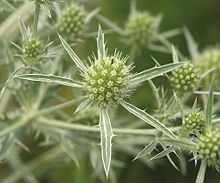Eryngium campestre
From Wikipedia, the free encyclopedia
| Eryngium campestre | |
|---|---|
 | |
| Scientific classification | |
| Kingdom: | Plantae |
| (unranked): | Angiosperms |
| (unranked): | Eudicots |
| (unranked): | Asterids |
| Order: | Apiales |
| Family: | Apiaceae |
| Genus: | Eryngium |
| Species: | E. campestre |
| Binomial name | |
| Eryngium campestre L. | |
Eryngium campestre (Field eryngo) is a species of Eryngium, which is used medicinally. A member of the Apiaceae family, Eryngo is a hairless, thorny perennial. The leaves are tough and stiff, whitish-green. The basal leaves are long-stalked, pinnate and spiny. The leafs of this plant are mined by the gall fly which is called Euleia heraclei.
Flowering season
July–September
Distribution
Mainly Central and southern Europe, north to Germany and Holland. Rare in the British Isles.
Uses
Used in herbalism as an infusion to treat coughs, whooping cough and urinary infections. Roots were formerly candied as sweets or boiled and roasted as a vegetable. Active Ingredients: Essential oils, saponins, tannins.
External links
- Plants For A Future: Eryngium campestre
- USDA Plants: Eryngium campestre
- Plant Profile of the Botanical Society of Britain and Ireland: Eryngium campestre
- Distribution Map of Eryngium campestre in continental France (Telebotanica)
This article is issued from Wikipedia. The text is available under the Creative Commons Attribution/Share Alike; additional terms may apply for the media files.
_2.jpg)